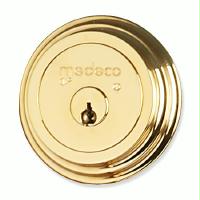 Many individuals, whether they own a home or not, are aware that the safest, most tamper proof variety of lock, within the affordable range of any home owner, is a deadbolt. Even the name conjures up an image of superiority when compared to other locks. It is a DEADbolt; it will hold, it must hold. Generally speaking, this is true. A deadbolt is great for protecting entrances to any premises, and there are many different varieties, ranging in price from affordable to the expensive and incredibly difficult to break or pick; something you may see at a military armory.
Many individuals, whether they own a home or not, are aware that the safest, most tamper proof variety of lock, within the affordable range of any home owner, is a deadbolt. Even the name conjures up an image of superiority when compared to other locks. It is a DEADbolt; it will hold, it must hold. Generally speaking, this is true. A deadbolt is great for protecting entrances to any premises, and there are many different varieties, ranging in price from affordable to the expensive and incredibly difficult to break or pick; something you may see at a military armory.
If your door frame is rotten, or the door itself falling apart, of course a simple kick will knock in your door. But that deadbolt will still be holding itself in one piece. Amongst those who pick locks to gain entry to locations, a deadbolt is formidable test, being a very heavy bolt for a lock picker to us his torque wrench to turn the bolt while also trying to locate the proper pins with his pick in order to get the bolt to turn. But I digress, the purpose of this article in not tell you what makes deadbolts so efficient and effective, but rather briefly discuss how they work.
Almost all locks work on a system including a cylinder containing pin tumblers, and a key, which hits the pin tumblers in just the right spot allowing the locking mechanism to be opened. The cylinder on a deadbolt itself can be adjusted if need be, not necessitating the complete change of the lock. Pins themselves can be removed and replaced within a good cylinder, requiring a change in the correct size of the teeth on a key. In layman’s terms, it needs new keys cut at that point. But only an experienced locksmith can change these pins, attempting to do so at home is foolhardy at best.
So what are the importance of the pins in this cylinder? These pins are essential to any key based locking mechanism, without them, there would be only very simple locks today. These pins are held in position by springs. When a key is left out of the lock, these springs move the pins out of position. This effectively locks, at least in the case of a deadbolt, the bolt itself in place, as the cylinder will not turn to move the bolt until the pins are returned to their compressed positions. Placing the correct key into the deadbolt cylinder will return these to their correct positions, allowing the key to be turned, either driving the deadbolt into the strong frame of the door thereby locking the door and vice versa.
In order to truly understand what makes a deadbolt work, and in fact work better, then many other locks available for doors, for example your front door, we must quickly understand how most other door locks work. The most frequently used door lock, or the one you see directly mounted on to door knobs, is of the spring loaded variety. This also relies on a key being inserted and pushing the pins into their proper positions so the bolt is freed. Unfortunately, this design makes your door very easy to “Jimmie” open, or simply knowing how and where to apply proper force so that the bolt slides back, allowing entrance to the residence. Also, it is a much simpler lock to pick in general if someone doesn’t want to make the same noise that “Jimmying” makes, and leave less obvious signs of break in. This is significantly differs from the dead bolt, which absolutely needs the turning of the cylinder to open, making it impossible to “Jimmie” open and more resistant to lock picking due to the heaviness of the bolt, though not invulnerable in most cases.
There are several types of deadbolts, some must be opened with a key from both sides, but most protecting households are single sided, meaning that there is a latch on the inside of the door which allows the door to be opened by an owner without rushing to find his keys. Overall, deadbolts are one of the oldest and still most tamper effective of household locks.











